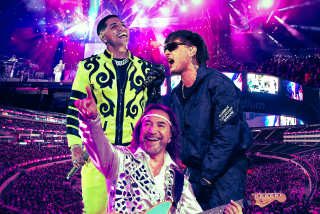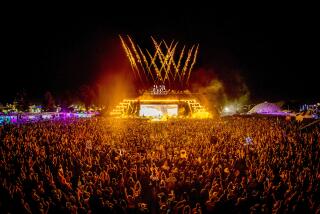How South by Southwest festival made an impression
In his keynote speech at the South by Southwest Music Festival and Conference in Austin, Texas, last week, singer Bruce Springsteen spoke at length about his musical story. The 62-year-old rock icon told the capacity crowd of his life as a fan, recalled the records that he fell in love with as a New Jersey teen, and conveyed the feeling of a shared victory when rock ‘n’ roll upended American youth culture and transformed the world.
Springsteen then ran down the many ways that his version of the story is long in the past, offering evidence by reeling off an amazing list of subgenres from today’s fractured American music scene. The list he came up with took at least a minute to reel off, and contrasted today’s music world with that of the 1950s and ‘60s, when a single moment like Elvis Presley on “The Ed Sullivan Show” or the arrival of a Beatles album in your local department store could make a dent in the overall culture. That doesn’t happen anymore, he said.
He is right — even if all of America did not, in fact, agree on Elvis. The fragmentation of popular music has been occurring for at least the past decade, the walls between subgenres and micro-scenes growing taller each day. And the system that used to feed our ears — commercial radio and major labels — become nothing but its own unique (albeit bigger) scene.
The five days of South by Southwest offered overwhelming evidence of a musical explosion blowing in countless directions, without any uniformity or common aesthetic, ranging from hard-core punk to country twang, from dry, deliberate synth pop to a wildly enthusiastic hip-hop contingent, from jangly guitar bands mimicking the sounds of 1965 to aggressive new dubstep. Each sound has its little tribe, each insular community its own brand of superstar, but few of these mini-stars seem able to break into mass consciousness.
The staggering amount of corporate sponsorship at the festival certainly didn’t help. Big names like Kanye and Lionel Richie were sponsored by even bigger names like Doritos and Pepsi, and that distracted from budding artists who’d been shoved onto much smaller stages with smaller sponsors.
To capture the myriad scenes and movements in Austin, here are five equally scattered observations about some of the moments that made an impression:
Hard-core is back: This year the young dudes are making a lot of punk rock. At one second-floor gig by young Los Angeles four-piece Fidlar, the slam-dancing and crowd-surfing got so frantic that a kid almost got his head sliced by a ceiling fan. This wasn’t the Green Day or Blink-182 variety, but the scuzzy, scary, pre-grunge kind built in basements and fueled on cheap beer, acne and testosterone.
You could hear the snare and drum pound of speed bumping out of a lot of clubs, especially on the east side of downtown, where the Thrasher party brought together some menacing hard-core, including the totally scary Heartless, which records for L.A.- based metal imprint Southern Lord, and Ceremony, which injected real-life fear into the Thrasher tent. One punk rock party had at least 50 punk bands playing over its two days.
So is Fiona Apple: Perhaps as a way to calm down during her Wednesday night gig in the backyard of Stubb’s BBQ, reclusive Los Angeles singer Apple closed her eyes between songs and said to the capacity crowd, “You’re imaginary, you’re not real.” It was her first full live performance in advance of her new album, “The Idler Wheel...,” and Apple seemed to be wishing us away so that she could concentrate. The more she wished, the more urgent her delivery became. She pushed her contralto to the edge, where her voice went gruff and crackled.
The 34-year-old played a combination of old and new songs, including a searing take on “On the Bound,” her Brechtian dirge, which she offered on grand piano. The recent work was of a part with the rest of her oeuvre: an odd but effective combination of rock, jazz, soul and blues that touched on all without committing to any. Like Apple’s best music, her lyrical drama was tempered with a certain swing and swagger that belies the message that, in Apple’s words during “Paper Bag,” “You know I’m a mess.” She wasn’t a mess at Stubb’s — even if she seemed as if she couldn’t wait to get off the stage. Not because of rudeness, though, but because she seems so much more at home when we in the crowd are imaginary.
Sounds of Colombia: The hype machine at South by Southwest is a powerful, expensive instrument, and on Friday night that engine was running on overdrive: Jack White on 6th Street, Skrillex a few blocks away at the Mohawk, Eminem and 50 Cent at the Shady party, all relentlessly pushing otherwise adventurous souls to feel guilty about resisting. I resisted, instead opting for a different adventure: Grupo Canalon, a traditional Colombian rhythm band centered around the magnetic sound of the marimba, a wooden xylophone that puts forth gentle, melodic tones.
The group had played earlier in the day at 5th and Brazos and, clad in matching white outfits, had drawn a sizable crowd of passersby. During the day, the dozen players/instrumentalists, including the marimba, congas, and five female vocalists/percussionists, crafted a sound that was a mishmash of African and Caribbean sounds.
In the evening, though, that same music transformed from outdoor curiosity into indoor dance music, and the little club Copa ended up jammed with enthusiastic dancers — and one of the least pretentious crowds at the festival. Let that be a lesson to the lemmings chasing would-be future indie stars: In Austin, it’s a good idea to break way from the pack every now and then.
Borgore with strippers: If the Israeli electronic producer Borgore is looking to distance himself from the dreaded “bro-step” tag that has become a dismissive description of the heavy, pounding, Skrillex-style bass music called dubstep that he trades in, he should think about ditching the two pole-dancers who stand on risers on either side of the producer while he performs.
His fans didn’t seem to mind during his Thursday set at the Parish, where his bass drops, the meat-and-potatoes hooks that typify dubstep, caused frenzy on the dance floor — and the poles. Dubstep’s presence was all over Austin this year, from Skrillex’s massive 1 a.m. throwdown at the Mohawk to hot L.A.-based producer 12th Planet’s Saturday sweat-fest at the Beauty Bar — even if the majority of hipster bloggers rolled their eyes and kept walking.
Best Coast on a roll: At the Hype Hotel, L.A. indie pop group Best Coast presented four new songs from its forthcoming album, “The Only Place,” during its set, and each highlighted singer Bethany Cosentino’s increasing vocal and onstage confidence. Where on earlier songs from the group’s breakout album, “Crazy for You,” she hid her voice beneath layers of Bobb Bruno’s distorted guitar, on the catchy but intricate melodies of new songs “Mean Girls” and “Last Year” she hit bigger notes with assurance, as though she’d spent her time between albums working on her delivery.
And as she bantered with audience members, she pleaded with them to be better than the other crowds had been during the band’s Austin experience, complaining with salty honesty about how they behaved. This was indeed an improvement, she finally concluded, especially while Cosentino was holding a cup of whiskey. “Chug, chug, chug, chug!” the crowd commanded, and she did.
More to Read
The biggest entertainment stories
Get our big stories about Hollywood, film, television, music, arts, culture and more right in your inbox as soon as they publish.
You may occasionally receive promotional content from the Los Angeles Times.










